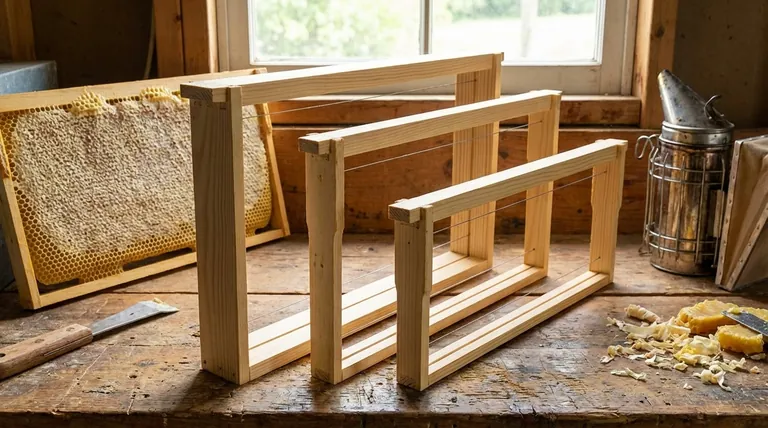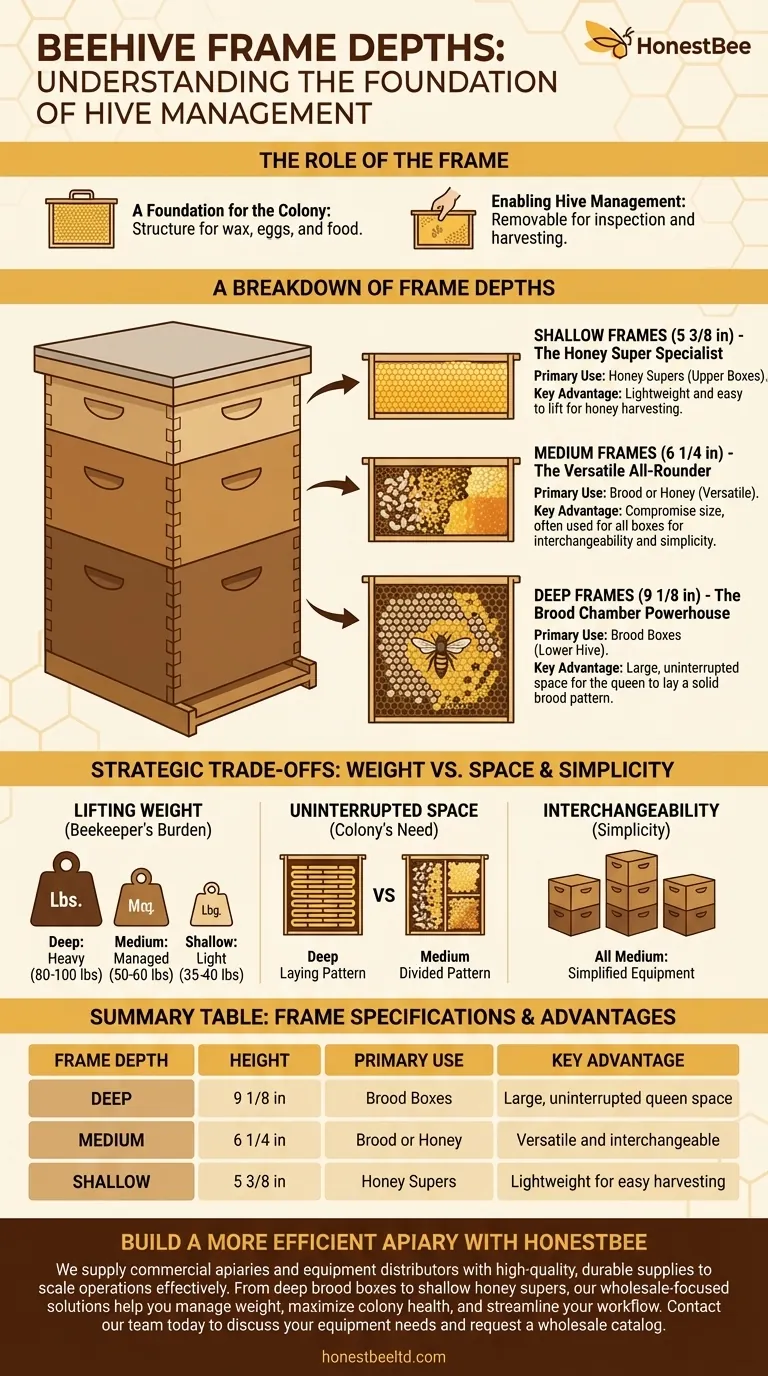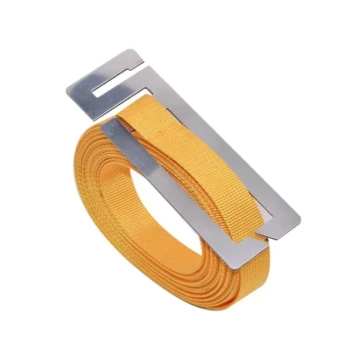At the heart of a managed beehive, there are three standard frame depths: deep, medium, and shallow. Deep frames are the largest and are primarily used in the lower hive boxes (brood boxes) to provide the queen ample, uninterrupted space for laying eggs. Medium frames offer a versatile middle ground, used for either brood or honey, while the smaller, lighter shallow frames are almost exclusively used in the upper boxes (honey supers) to make honey harvesting more manageable.
The choice of frame depth is a foundational decision in beekeeping. It goes beyond simple dimensions, directly influencing your hive management strategy by forcing a trade-off between providing optimal space for the colony and the physical lifting weight you are willing to handle.

The Role of Frames in the Hive
Before comparing depths, it’s crucial to understand the function of a frame. It is the single most important innovation for modern beekeeping.
A Foundation for the Colony
Frames provide a rigid structure that holds a sheet of foundation, which is the physical plane where bees build their wax honeycomb. This organized structure is where the queen lays her eggs and where worker bees store pollen and nectar.
Without frames, bees would build comb attached to the hive walls, making inspection impossible without destroying the colony's work.
Enabling Hive Management
Frames are designed to be removable. This allows a beekeeper to slide individual frames out for inspection, checking on the queen's health, looking for signs of disease, and assessing food stores.
This removability is also what makes honey harvesting possible without destroying the hive itself.
A Breakdown of Frame Depths
Each frame depth is designed to fit in a corresponding hive box and serves a distinct purpose.
Deep Frames: The Brood Chamber Powerhouse
Deep frames are the largest option, typically around 9 1/8 inches tall. They are used in the bottom boxes of the hive, known as the brood boxes or hive bodies.
Their primary advantage is the large, continuous surface area they provide. This allows the queen to lay her eggs in a natural, unbroken pattern, which is essential for raising a strong and healthy workforce for the colony. These frames also hold significant pollen and honey reserves for the bees' own use.
Medium Frames: The Versatile All-Rounder
Medium frames, often called "Illinois supers," are about 6 1/4 inches tall. They represent a compromise between the deep and shallow sizes.
Their key benefit is versatility. Many beekeepers choose to use medium frames and boxes for their entire hive—both for the brood chamber and for honey supers. This creates a system with completely interchangeable parts, simplifying equipment needs.
Shallow Frames: The Honey Super Specialist
Shallow frames are the smallest, measuring around 5 3/8 inches tall. They are almost always used in the upper hive boxes, known as honey supers.
Their purpose is singular: to collect honey for the beekeeper to harvest. Because honey is incredibly dense and heavy, a shallow box full of honey is significantly lighter and easier to lift than a full medium or deep box.
Understanding the Trade-offs: Weight vs. Space
Your choice of frame depth is a strategic decision that directly impacts your beekeeping experience.
The Beekeeper's Burden: Lifting Weight
Weight is the most critical factor for the beekeeper. A deep box filled with honey and brood can weigh 80-100 pounds (36-45 kg). A medium box is more manageable at 50-60 pounds, while a shallow box is the lightest at 35-40 pounds.
This physical reality is often the deciding factor, especially for beekeepers with back problems or less physical strength.
The Colony's Need: Uninterrupted Space
From the bees' perspective, a larger frame is often better. A deep frame allows the queen to maintain a large, solid brood pattern without being interrupted by the wooden frame edges. This can lead to a more robust and productive colony.
Using smaller medium boxes for brood requires the queen to cross between two boxes to achieve the same laying area, which is less ideal but perfectly functional.
The Interchangeability Factor
The appeal of using a single size, typically all medium boxes, cannot be overstated. It simplifies everything. You never have to worry if you are grabbing the right size frame for the box you are inspecting. This efficiency is a powerful argument for forgoing the "ideal" deep brood box.
Making the Right Choice for Your Setup
Ultimately, the best configuration depends entirely on your personal goals and physical capabilities.
- If your primary focus is maximizing the queen's laying space: Use deep frames for your one or two bottom brood boxes and medium or shallow frames for your honey supers.
- If your primary focus is minimizing heavy lifting: Use medium frames for your brood boxes and shallow frames for your honey supers.
- If your primary focus is simplicity and interchangeability: Use medium frames for the entire hive, including both brood boxes and honey supers.
Choosing your frame depth is the first step in designing a beehive that works for both you and your bees.
Summary Table:
| Frame Depth | Height | Primary Use | Key Advantage |
|---|---|---|---|
| Deep | 9 1/8 in | Brood Boxes | Large, uninterrupted space for the queen |
| Medium | 6 1/4 in | Brood or Honey | Versatile and interchangeable |
| Shallow | 5 3/8 in | Honey Supers | Lightweight for easy honey harvesting |
Ready to build a more efficient apiary?
Choosing the right frame depth is just the beginning. At HONESTBEE, we supply commercial apiaries and beekeeping equipment distributors with the high-quality, durable supplies needed to scale operations effectively. From deep brood boxes to shallow honey supers, our wholesale-focused solutions help you manage weight, maximize colony health, and streamline your workflow.
Contact our team today to discuss your equipment needs and request a wholesale catalog.
Visual Guide

Related Products
- Wooden Bee Hive Frames for Beekeeping and Wholesale
- Copper Bee Frame Eyelets for Beekeeping
- HONESTBEE Durable Frame Wiring Board with Integrated Tensioner
- Professional Galvanized Hive Strap with Secure Locking Buckle for Beekeeping
- 24 Frame Honey Extractor Commercial Radial Honey Frame Extraction Machine
People Also Ask
- What are the primary uses of different Langstroth frame sizes? Optimize Your Hive for Health & Honey
- What is the role of oxalic acid in plants? A Key to Plant Defense and Internal Regulation
- What is the recommended number of frames for a beginner beekeeper? The Essential Rule for a Healthy Hive
- What are the standard sizes of frames used in Langstroth hives? Choose the Right Frame for Your Apiary
- When should bee frames be thrown away? A Beekeeper's Guide to Hive Health & Biosecurity



















